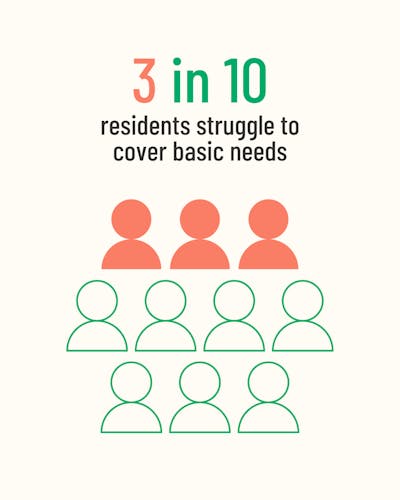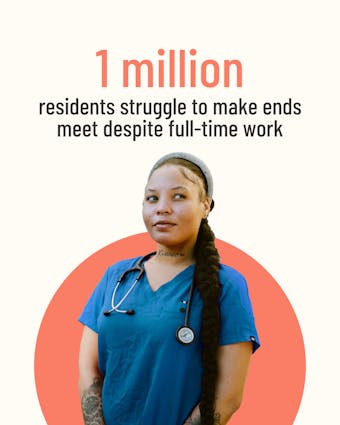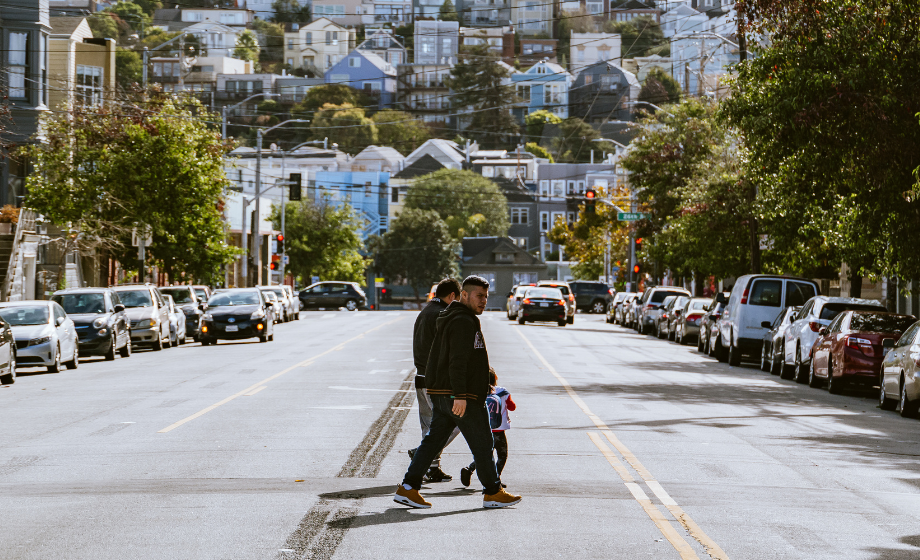Bay Area Poverty Backslides: A Decade of Progress Reversed
Each year, Tipping Point publishes findings on the state of poverty in our annual “Shedding Light on Bay Area Poverty” report, developed with data from the Public Policy Institute of California. The latest report, detailing data through the end of 2023, delivered striking findings: after nearly a decade of steady progress, poverty in the Bay Area is rising again.
The following key takeaways from the report highlight the urgent need for both strong programs and policy change to deliver lasting results in the fight against poverty. Read the full report here.
1. Over 1.8 million Bay Area residents struggle to make ends meet

The Bay Area’s poverty rate climbed from 12.2% in early 2023 to 16.3% by the end of the year—a 4.1% increase, representing over 245,000 additional people living below the poverty line.
Another 790,000 residents hover just above it, unable to meet the region’s steep cost of living. In total, more than 1.8 million Bay Area residents, nearly 3 in 10 residents, are struggling to cover basic needs.
While wages have risen for some Bay Area residents, many families near the poverty line are now receiving fewer safety net benefits—likely because even modest in come gains push them above federally defined eligibility thresholds.
These trends reveal the fragility of economic progress in the Bay Area—and how quickly residents can fall behind when the cost of living outpaces both wages and the reach of the safety net.
2. The cost of living is rising faster than wages

Even as wages have grown, the Bay Area’s affordability crisis continues to deepen. Between 2016 and 2023, household incomes increased by 34%, while the cost of living rose 46%. From 2021 to 2023 alone, prices for essentials surged 18%, including a 17% jump in grocery costs.
The widening gap between wages and expenses highlights the urgent need for programs and investments that make basic necessities—like housing, childcare, and food—more affordable.
3. Half of people living in poverty have full-time jobs

In the Bay Area, a full-time job does not guarantee economic security. Half of all Bay Area residents living in poverty belong to families with at least one full-time, year-round worker. In total, more than one million residents still can’t meet the region’s high cost of living despite full-time work.
The data underscores that prosperity in the Bay Area remains uneven, revealing that full-time employment alone isn’t enough to ensure economic security.
Looking Ahead
The Bay Area’s poverty rate in 2023 has returned to levels last seen in 2016—but this trend is reversible. For much of the previous decade, poverty had been declining. From 2011 to 2021, the Bay Area’s rate fell from 18.7% to 10.8%. The decade of progress before 2021 proved that with effective programs and policies, poverty can decline.
Tipping Point has expanded its focus beyond funding direct services that meet urgent needs today, to include investments in systems and policies that create lasting change.
Our priorities include:
- unlocking public funding to build and preserve affordable housing so families can stay in their communities;
- expanding access to childcare, allowing parents to work, earn, and build stability;
- investing in innovative training and apprenticeship programs that connect residents to quality jobs with real career pathways;
- improving college completion rates for low-income students, ensuring higher education is truly a gateway to financial independence;
- and increasing access to and preserving social safety net programs.
Altogether, these efforts aim to ensure that we not only respond to the urgency of rising poverty now, but invest in the systems level work that prevents poverty before it begins.





